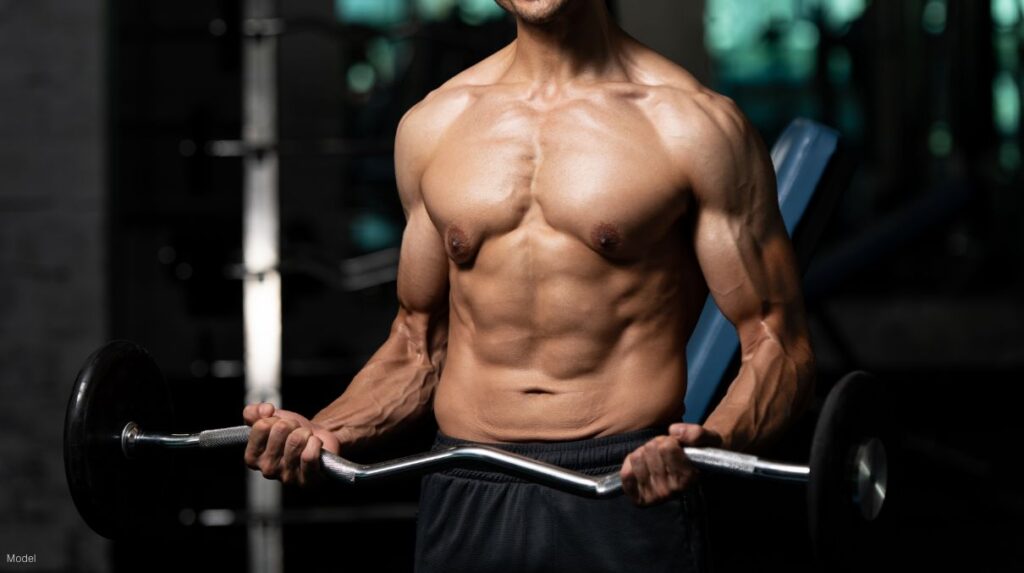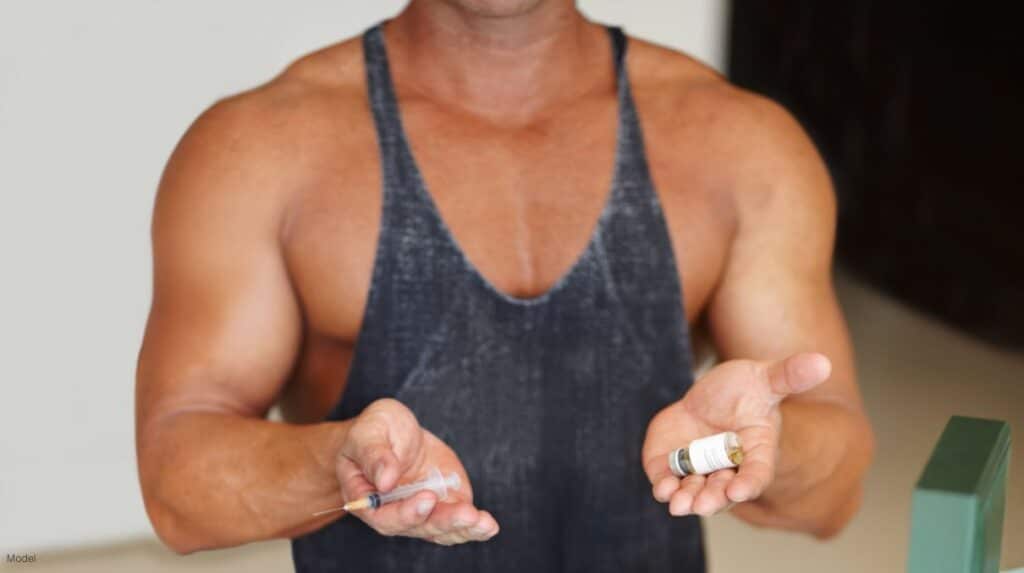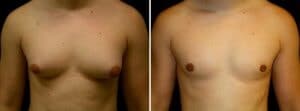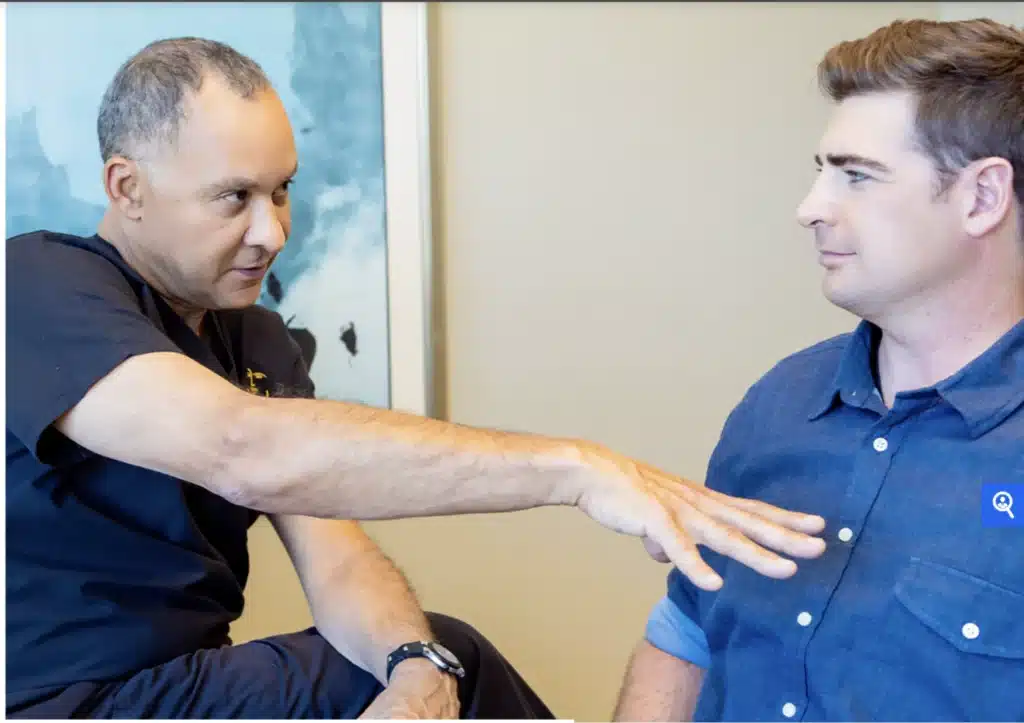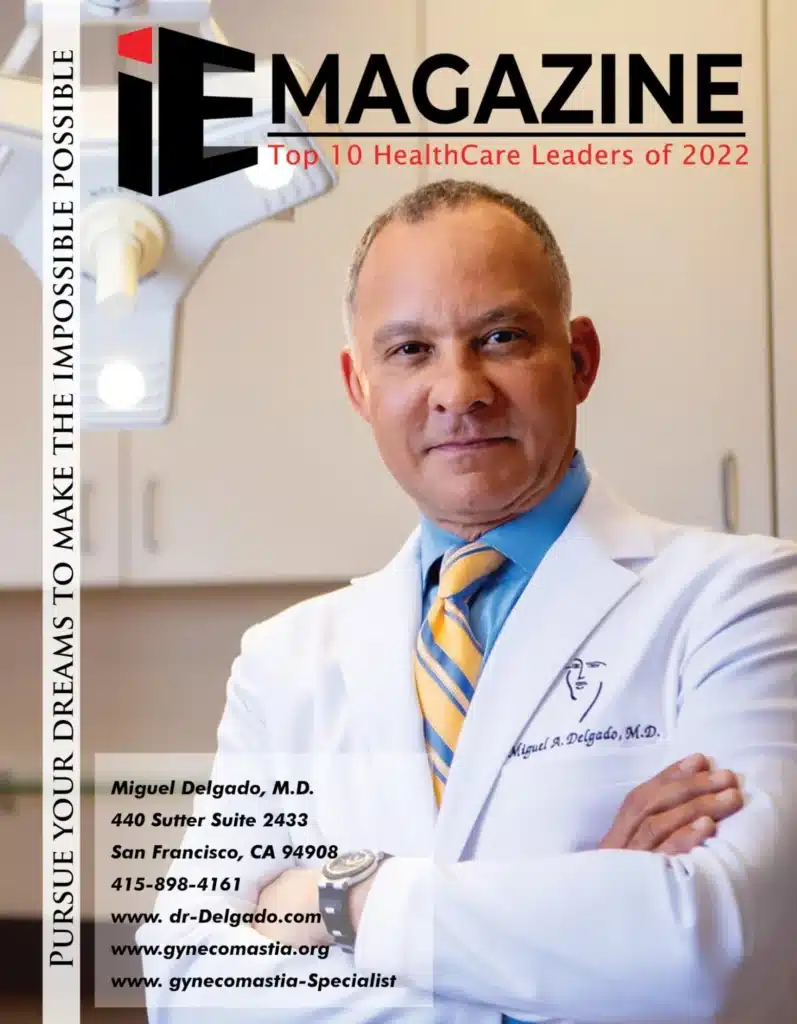Steroid-induced gynecomastia arises when steroids disrupt hormone equilibrium, leading to the growth of male breast tissue. This article delves into the causes, symptoms, and treatments of steroid-induced gynecomastia, providing valuable insights to help you identify and manage this condition effectively.
Key Takeaways
- Anabolic steroids can disrupt hormone levels in males, leading to an imbalance of estrogen and testosterone, which is a key cause of gynecomastia.
- Early detection of symptoms such as enlarged breast tissue and puffy nipples is crucial for effective management of steroid-induced gynecomastia.
- Treatment options for gynecomastia include medications like Tamoxifen and surgical interventions, with personalized treatment plans essential for optimal outcomes.

Understanding Steroid Induced Gynecomastia
The development of abnormal glandular tissue in the breast area of men, known as gynecomastia, is frequently a consequence of hormone equilibrium disruptions. The use of anabolic steroids to promote muscle growth can cause significant disruptions in hormone levels for male bodybuilders, often leading to an increase in estrogen and a decrease in testosterone. This hormonal imbalance is a major factor in the onset of gynecomastia, which can develop even if one maintains a fit appearance. It manifests as excess glandular breast tissue and breast enlargement.
It is essential for individuals involved in bodybuilding or considering the use of steroids to be aware of their potential connection to significant gynecomastia. While steroids can enhance muscle mass, they also carry risks, including the potential to develop gynecomastia if not used responsibly. Early recognition of symptoms and timely action can potentially reverse the condition. In more advanced cases, invasive treatment methods might be necessary.
Hormonal Imbalance and Gynecomastia
The use of steroids can upset the hormone balance within the male body, notably altering the equilibrium between testosterone and estrogen. The introduction of these substances may cause a surge in estrogen compared to testosterone, promoting growth in glandular tissue within breast areas. This hormonal shift greatly contributes to gynecomastia, because heightened levels of estrogen can trigger breast tissue development, leading to a chest that appears more feminine.
Male bodybuilders who strive for a distinctly masculine-looking chest find it particularly troubling when they develop gynecomastia due to increased levels of estrogen. These conditions not only impact their physical appearance, but also undermine their self-confidence and perception of body image. The unwanted changes associated with breast development can be particularly distressing.
Understanding how steroids interfere with hormone balance is crucial for both preventing and managing occurrences of gynecomastia effectively.
Symptoms of Steroid-Induced Gynecomastia
Prompt recognition of symptoms that indicate the onset of gynecomastia, especially when induced by steroids, is crucial for efficient treatment. Symptoms to watch out for include swelling of breast tissue, excess glandular tissue, nipples becoming puffy, and tenderness in the chest region. The degree to which individuals are affected can vary widely. Some individuals may observe only minor changes, while others might experience substantial enlargement of the breast tissue, which negatively affects both their appearance and comfort levels.
Carefully monitoring any changes in the size or shape of breast tissue, as well as alterations around the nipple areas, is crucial for those using anabolic steroids. This vigilance facilitates the early detection of gynecomastia, allowing access to less invasive treatment options. This provides the opportunity to pursue less invasive treatments. On the other hand, neglecting these early warning signs may result in severe gynecomastia, necessitating surgical intervention as a corrective solution.
Why Anabolic Steroids Cause Gynecomastia
The development of gynecomastia from steroids is primarily due to their effects on hormone levels within the body. By upsetting the equilibrium between androgens and estrogen, these substances cause a relative rise in estrogen compared to testosterone. This shift towards hormonal imbalance is what chiefly contributes to breast tissue growth, thereby instigating gynecomastia.
For individuals like athletes and bodybuilders seeking muscle enhancement benefits, the impact of anabolic steroids on hormones poses a significant drawback. Although these compounds are adept at fostering muscle growth, they simultaneously elevate the risk of one developing gynecomastia when not meticulously managed. It’s important for anyone contemplating the use of steroids to be fully aware of this potential consequence.
Role of Estrogen in Breast Tissue Growth
Elevated estrogen levels are a significant factor in the enlargement of male breast tissue. Disruption of the hormonal equilibrium between estrogen and testosterone, which commonly occurs with steroids, prompts an increase in glandular tissue within the breasts. This noncancerous expansion of breast tissue can lead to gynecomastia, particularly evident in men with reduced body fat.
Elevated estrogen levels create a hormonal environment that promotes growth in breast tissues, potentially leading to conditions like gynecomastia. Consequently, drugs with anti-estrogen properties are frequently employed to prevent and manage gynecomastia that arises from steroid use by mitigating the impact of heightened estrogen levels.
Impact of Dosage and Duration
The risk of developing gynecomastia from anabolic steroid use is significantly influenced by the dosage and duration of use. Higher dosages and extended periods of steroid use increase the likelihood of hormonal imbalances that lead to gynecomastia.
Factors such as the specific type of steroid used and individual genetic predisposition also play a role in determining the risk.
Prevention Strategies for Steroid-Induced Gynecomastia
Before: The best way to prevent steroid-induced gynecomastia is to avoid anabolic steroids entirely. Engaging in regular physical activity and adhering to a balanced diet can help regulate hormone levels and decrease the likelihood of developing gynecomastia. Regular medical check-ups help monitor hormone levels and detect early signs of gynecomastia.
After: To prevent steroid-induced gynecomastia, consider the following strategies:
-
- Avoid anabolic steroids entirely.
- Engage in regular physical activity and maintain a balanced diet to help regulate hormone levels and manage weight, reducing the risk of developing gynecomastia.
- Schedule regular medical check-ups to monitor hormone levels and detect early signs of gynecomastia.
Combining resistance training and cardiovascular workouts can reduce body fat and preserve muscle, helping prevent gynecomastia. These lifestyle changes, combined with regular medical evaluations, form a comprehensive approach to preventing the onset of gynecomastia caused by anabolic steroids.
Natural Supplements and Balanced Diet
Adhering to a balanced diet and incorporating natural supplements can support the regulation of hormone levels, which is instrumental in mitigating the risk associated with gynecomastia. To target body fat reduction and enhance chest muscle definition, low-impact cardio workouts like swimming or rowing machine sessions are beneficial. Engaging in high-intensity interval training (HIIT) has been shown to be an efficient way to accelerate fat loss and reduce the prominence of gynecomastia.
To decrease body fat, improve how gynecomastia looks, it’s recommended to carry out consistent cardiovascular activities. When these exercises are paired with a nutritious diet rich in essential nutrients needed for hormonal equilibrium, they work synergistically to prevent potential development of gynecomastia.
Regular Medical Check-Ups
Routine health examinations are vital for keeping track of hormone levels and identifying initial indicators of gynecomastia. If changes in the chest area become apparent due to steroid use, it is advised to seek advice from a medical professional promptly for early identification and treatment.
If an individual is taking medications recognized as culprits in causing man-boobs, they should consider speaking with their doctor about possible alternative drugs.
Treatment Options for Steroid Induced Gynecomastia
Various treatment options exist to treat gynecomastia resulting from steroid use, encompassing both medication and surgery. Medications like tamoxifen and aromatase inhibitors are effective in countering the effects of estrogen on breast tissue, thus limiting its enlargement. If gynecomastia persists despite medical therapy, surgical procedures such as liposuction and excision of glandular tissue may be employed to achieve a more traditionally male chest contour. Selecting an appropriate treatment is crucial for one’s physical comfort and emotional health.
Consultation with a plastic surgeon or gynecomastia specialist is advisable for those affected by gynecomastia to fully comprehend their condition and consider all possible treatments. The choice between pharmaceutical intervention and surgery offers distinct advantages. Therefore, it is important to create a personalized treatment plan carefully tailored to the specific needs of individuals experiencing gynecomastia.
Medications for Treating Gynecomastia
Aromatase inhibitors, including anastrozole and letrozole, as well as Tamoxifen, are often recommended for treating gynecomastia. While aromatase inhibitors act to lower the body’s estrogen levels, Tamoxifen directly counters estrogen’s effects on breast tissue, thereby curbing the enlargement of glandular tissue.
Engaging with a healthcare provider, like an endocrinologist, is crucial to grasp the nuances of various medications and approaches available for managing gynecomastia. These pharmaceutical options can significantly address this condition when recognized early in its development.
Surgical Solutions
STEROID INDUCED GYNECOMASTIA AFTER SURGERY
For individuals suffering from enduring gynecomastia or pseudogynecomastia that is unresponsive to medicinal treatments, surgical intervention might be required. Standard surgeries include liposuction for the elimination of excess fatty tissue, and excisional surgery to deal with growths in glandular tissue.
The objective of these surgical methods is to achieve a chest appearance that is more masculinized and flat.
Postoperative Care and Recovery
Following surgery treatment, appropriate postoperative attention is crucial for a successful recovery. Whether the procedure involves liposuction for pseudogynecomastia, which is less invasive and requires vigilant observation during healing, or excision of glandular tissue, which may require more comprehensive care after surgery.
Adherence to post-surgical guidelines and consistent check-ups are essential in ensuring an optimal result from the treatment.
Benefits of Seeking Medical Advice
Engaging with healthcare professionals, including a board-certified plastic surgeon, offers significant benefits for individuals dealing with gynecomastia. It allows for the identification of hormonal imbalances through routine blood tests and evaluations. This early identification helps prevent gynecomastia by allowing timely interventions. Medical experts can offer customized treatment options tailored to meet the individual requirements of each patient.
Regular medical check-ups allow continuous monitoring of hormone levels and offer a chance to detect early signs of potential gynecomastia. By maintaining this proactive approach, the effectiveness of management strategies is enhanced, leading to improved health outcomes for those dealing with this condition.
Monitoring and Follow-Up
Regular follow-up appointments are essential for tracking progress and adjusting the treatment plan as needed.These scheduled check-ins enable an evaluation of how well treatments are working, and allow improvements to optimize results.
Persistent oversight is imperative in effectively handling gynecomastia, ensuring that management strategies remain appropriate as conditions evolve.
Alternative Training Methods for Individuals with Gynecomastia
Incorporating specific chest exercises into a regular fitness routine can be beneficial for those dealing with gynecomastia. By strengthening the pectoral muscles, these exercises can reduce the appearance of gynecomastia. It’s important to balance workout routines with both cardiovascular and strength training to effectively manage symptoms and improve body image.
Utilizing these alternative training methods not only enhances physical health, but also boosts confidence and self-esteem. Understanding and implementing these techniques can be crucial for individuals to effectively manage the challenges associated with gynecomastia.
Chest Exercises to Reduce Appearance
Exercises that focus on the chest, such as bench presses, push-ups, and chest flies, can greatly influence how gynecomastia looks by strengthening the pectoral muscles. These particular exercises are effective in building muscle in the chest region and diminishing excess fat.
With regular practice of these targeted chest exercises, there will be a steady enhancement in the contour and general visual aspect of the chest area.
Adjusted Workout Routines
Incorporating both cardiovascular exercise and strength training into an exercise regimen can be a powerful approach to addressing gynecomastia. Cardiovascular workouts help cut down body fat, while strength exercises increase muscle tissue, especially around the chest.
Making these changes contributes not only to mitigating the visual symptoms of gynecomastia, but also boosts general health and promotes greater self-esteem regarding one’s physique.
Why Choose Dr. Delgado for your Gynecomastia Surgery?
Dr. Delgado boasts over 30 years of experience and holds board certification, earning international acclaim for his expertise in treating gynecomastia. As a specialist in male breast reduction surgeries, he has built a global reputation for successfully helping numerous patients. The high patient satisfaction ratings he consistently receives attest to his outstanding surgical skills, personalized approach, and steadfast commitment to achieving exceptional aesthetic outcomes.
As the guiding force behind Gynecomastia.org as its medical director, Dr. Delgado offers crucial support and information to individuals grappling with this condition. His dedication extends beyond primary care. He is notably skilled in performing revision surgeries, which strengthens his credibility among those seeking remedy for gynecomastia symptoms. Opting for Dr. Delgado’s expertise not only means securing exemplary surgical capabilities, but also engaging in a compassionate environment centered on patient well-being.
Summary of Steroid Induced Gynecomastia
Gynecomastia, frequently triggered by anabolic steroids, is a common concern among individuals in the bodybuilding and fitness communities. Recognizing that these steroids create hormonal imbalances that lead to the condition is crucial for prevention and management. Symptoms such as enlarged breast tissue can cause significant distress, but early detection enhances the chances of successful treatment.
Avoiding anabolic steroids is a key preventive strategy, complemented by maintaining a healthy lifestyle through balanced diets and regular exercise, along with routine health check-ups. For those already affected by gynecomastia, there are various treatment options, from medications to surgical interventions. Personalized treatment plans and continuous monitoring by healthcare professionals are essential for effectively managing this condition.
Call Dr. Delgado to schedule a consultation – Today!
Whether you’re seeking a comprehensive evaluation or exploring treatment options, Dr. Delgado’s clinics offer expert guidance and personalized care for those dealing with gynecomastia. His experienced team is dedicated to providing support throughout your journey, ensuring that you receive the most effective and appropriate treatment for your needs. With a focus on achieving optimal aesthetic results and enhancing patient satisfaction, Dr. Delgado’s practice is committed to helping you regain confidence and improve your quality of life. Schedule a consultation today to take the first step towards addressing your gynecomastia concerns
Contact us today at 415-898-4161 or visit Dr. Delgado in San Francisco by scheduling an in-person or virtual consultation and taking the first step towards addressing your gynecomastia concerns.
Frequently Asked Questions
What causes gynecomastia in males using anabolic steroids?
Gynecomastia in males using anabolic steroids is primarily caused by hormonal imbalances, specifically an increase in estrogen levels relative to testosterone. This disruption is a direct result of anabolic steroid use.
What are the common symptoms of steroid-induced gynecomastia?
Gynecomastia resulting from steroid use typically manifests as tenderness and sensitivity near the nipple, evident enlargement of breast tissue, and swollen nipples.
It is critical to identify these signs promptly for effective treatment.
Can gynecomastia resolve on its own if I stop using steroids?
Gynecomastia could stabilize upon discontinuing steroid use, but existing tissue growth is unlikely to regress without medical or surgical intervention.
Are there non-surgical ways to manage gynecomastia?
Non-surgical management of gynecomastia is indeed possible through medications such as Tamoxifen and aromatase inhibitors, which block estrogen effects and reduce breast tissue growth.
Such treatments can be effective in addressing the condition without surgery.
What does gynecomastia surgery involve?
Gynecomastia surgery involves making an incision around the areola to remove excess breast tissue, resulting in a more masculine chest contour. This approach effectively addresses the physical concerns associated with gynecomastia.

